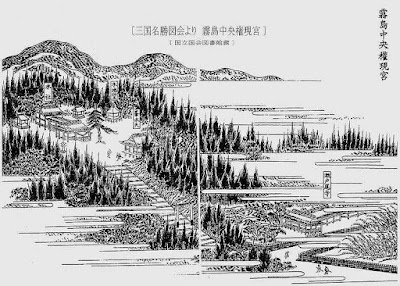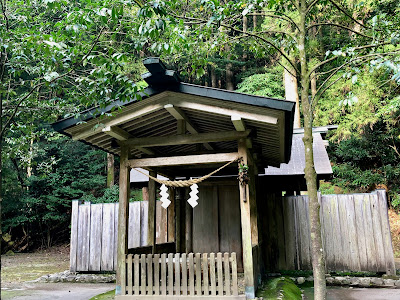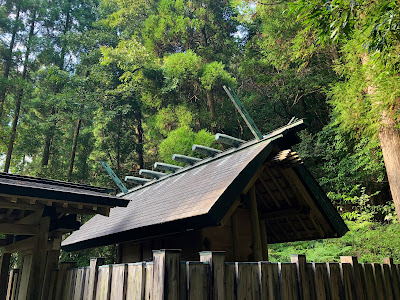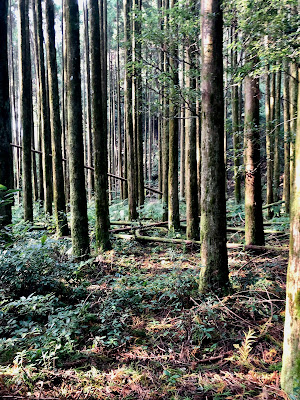.jpeg) |
| 霧島神宮・境内マップ : ★ 9月26日 ~ 10月1日、私と姉Yは、鹿児島県へ旅行しました。 本日、29日は、鹿児島交通タクシーのSさんの案内で、 鹿児島市内から霧島温泉郷 (キリシマオンセンキョウ) を目指して、 観光をしました。 このセクションは、'霧島神宮 - 華林寺跡' についてです。 Kirishima-jingu Shrine Precinct Guide Map in Japanese From 26th of September to 1st of OctoberI and my sister Y travelled to Kagoshima Prefecture. Today, on the 29th, we went sightseeing from Kagoshima City to Kirishima Hot Springs Village with Kagoshima Kotsu Taxi's driver, S San. This section is about 'Kirishima-Jingū Shrine - Site of Karin-ji Temple'. .jpeg) 華林寺跡・境内マップ Site of Karin-ji Temple Map 画像は下記より / These from below ★ |
目次/ Contents
1) 性空上人墓 / Shouku Shonin Grave
A. 旧参道下 / Bottom of the Old Approach
B. 神仏習合 / Shinbutsu-shūgō
2) 華林寺 / Kerin-ji Temple
3) 鎮守神社 / Chinjyu Shrine
4) 兼慶上人墓 / Kenkei Shonin Grave
A. 兼慶上人と霧島神宮
Kenkei Shonin and Kirishima-jingu Shrine
B. 周囲 / Surroundings
1) 性空上人墓 / Shouku Shonin Grave
A. 旧参道下 / Bottom of the Old Approach
旧参道 (亀石坂) 下に性空上人 (ショウクウ ショウニン / 910 - 1007) のお墓があります。
霧島神宮の公式マップに、'性空上人墓'と載っているので、ここではそう書きますが、実際に上人に由来する遺骨やなにかが埋葬されているのかはわかりません。
供養塔と呼ばれる方もいるようです。
撮影した時には、私は、性空上人について何も知りませんでしたし、石塔が、記念碑なのか、お墓なのかさえもよくわかっていませんでした。
おそらくお墓であろう...と推測はしました。
けれども、その場の雰囲気や山林の中にあるお墓の有様になにか、
特別なもの、異質なものを感じて撮影しました。
 |
| 性空上人墓 1007年、性空上人は、播磨国 (ハリマノクニ/ 現・兵庫県) の 弥勒寺 ( ミロクジ)で亡くなりました。 ですが、お墓がここにあることに驚きます。 弥勒寺は、現在は、'書写山圓教寺 (ショサザンエンギョウジ) の奥の院'と呼ばれています。 Shouku Shonin Grave In 1007, Shouku Shonin died at Miroku-ji Temple in Harima Province (now Hyogo Prefecture) . But the tomb is here, so I'm surprised. Miroku-ji Temple is now known as 'Okunoin of Shosazan Engyō-ji Temple'.  近年、弥勒寺にて上人の坐像 (木像 / 1288年制作) が発見され、 奈良博物館でX線検査をし、頭部に遺骨が 収められていることがわかりました: ★/ ★。 In recent years, a seated statue of Shonin (a wooden statue/created in 1288) was discovered at Miroku-ji Temple and an X-ray examination at the Nara Museum revealed that the head contains a true bone. |
Bottom of the Old Approach
There is a grave of Shouku Shonin (910 - 1007) the bottom of the old approach (Kameishizaka: Turtle Slope).
On the official map of Kirishima-jingu Shrine, it says 'Shouku Shonin Grave' (in Japanese), so I write that here, but I don't know if there are actually any remains or anything related to Shonin buried there.
It seems that some people call it a 'Memorial Tower'.
At the time of photographing, I didn't know anything about Shuoku Shonin, and I wasn't even sure if the stone was a monument or
a grave.
I assumed it was probably a grave.
However, I felt something special, something different, in the atmosphere of the place and the state of the tomb in the forest, so
I photographed.
 |
| 墓誌? 性空上人についての説明が されていると思われますが私には読めません。 Epitaph? It seems that there is an explanation about Shouku Shonin, but I can't read it. |
 |
| 周囲の景色 ここは、霧島連山の第二峰、 高千穂峰 (タカチホノミネ/1547m) の麓 (フモト) に なります。 Surrounding View Here is the foot of Takachiho-no-mine (1574m) , the second highest peak of Kirishima mountains.  わずかながら人工物に見えるものがあり、 ここに何か (寺が?)あったのかもしれないと思わせます。 There is something that seems to be a little man-made, and it makes me think that something (a temple?) might have happened here. |
B. 神仏習合 / Shinbutsu-shūgō
性空上人については、以前のブログ (下のセクション) に書いていますが、再びここで触れます。
性空上人は、910年、京都に生まれ、36歳の時に出家します。
霧島神宮は540年創建、その後、何度も噴火により炎上し、788年で焼失していました。
性空上人は、村上天皇 (ムラカミ テンノウ / 926 - 967 / 在位 : 946 - 967) の治世下、950年に社殿を
高千穂河原 (タカチホガハラ) に移し、再興しました。
(現在、ここは "霧島神宮・古宮址" (フルミヤアト) になっています。)
また、上人は、霧島山を囲むようにして、
思想 (ホンジスイジャクシソウ) による神号である。
権現には山王神道(天台宗)・両部神道(真言宗)に基づくものや、自然崇拝(山岳信仰)と修験道が融合したもの等があり、民間信仰においては地域の名士や不慮の死を遂げた人物などが死後に権現として祀られる例も見られる。"
一気に、短い期間で六社も手がける上人は、いろいろな意味で、方面で、力があり、人徳もあった方だったのだと推測します。
Wikiには、"存命中から多くの霊験があったことが伝えられている"と書かれています。
上人は、霧島での修行、霧島六社権現の整備を終了し、霧島を離れます。
現在の公式の神宮マップには、'別当・華林寺跡' と記載されています。
'性空上人墓'もマップに記載されています。
霧島六社権現 / Kirishima Roku-sha Gongen
 |
霧島中央権現宮 ( キリシマチュウオウ ゴンゲングウ)。 別当・瀬多尾寺 (ベットウ・セトオノジ) 『三国名勝図会 (サンゴクメイショウズエ/ 1843)』より 1) Kirishima-mine Shrine Kirishima Central Gongengu Betto-ji Temple - Setoono Temple From "Sangoku Meishouzue /1843" (National Diet Library Digital Collections) 画像は下記より / This from below |
Roku means 6 : six.
Betto-ji Temple was a Buddhist temple that was attached to a Shinto shrine when the syncretism of Shinto and Buddhism was permitted prior to the Edo period.
 |
2) 東霧島神社 (ツマキリシマ ジンジャ) 東霧島権現社 (ツマキリシマ ゴンゲンシャ)。 別当・勅詔院 (ベットウ・チョクショウイン) 『三国名勝図会』より 2) Tsuma-kirishima Shrine Tsuma-kirishima Central Gongensha Betto-ji Temple - Chokusho-in Temple From "Sangoku Meishouzue" 画像は下記より / This from below |
 |
 |
4) 霧島西神社 (キリシマ ニシジンジャ) : 現・霧島神宮 西御斎所霧島権現社 (ニシゴザイショ キリシマゴンゲンシャ) 別当・華林院 (ベットウ・ケリンイン ) : 華林寺 (ケリンジ) 『三国名勝図会』より 亀石が描かれていて、ちょっと微笑ましく感じます。4) Kirishima-West Shrine (Today, Kirishima-jingu Shrine) West Gozaisho Kirishima Gongensha Betto-ji Temple - Kerin-ji Temple From "Sangoku Meishouzue" 'Turtle Stone' is drawn, and I feel a little charming. 画像は下記より / This from below★ |
 |
5) 夷守神社 (ヒナモリジンジャ ) 夷守権現社 (ヒナモリゴンゲンシャ) 別当・宝光院 ( ベットウ・ホウコウイン) 現在、雛森神社 (ヒナモリジンジャ) として 霧島岑神社に合祀 (ゴウシ)。 『三国名勝図会』より 5) Hinamori Shrine Hinamori Gongensha Betto-ji Temple - Houkou-in Temple Currently, it is enshrined together with Kirishimamine Shrine as Hinamori Shrine. From "Sangoku Meishouzue" 画像は下記より / This from below |
 |
狭野大権現 (サノダイゴンゲンシャ) 別当・神徳院 (ベットウ・シントクイン) 『三国名勝図会』より 6) Sano Shrine Sano-dai Gongensha Betto-ji Temple - Shinoku-in Temple From "Sangoku Meishouzue" 画像は下記より / This from below |
Shinbutsu-shūgō
I wrote about Shouku Shonin in a previous blog (section below), but I'll mention it here again.
Shouku Shonin was born in Kyoto in 910 and entered the priesthood at the age of 36.
(Shonin means a monk, a priest, a saint or a holy priest.)
He was a Lotus Sūtra follower belonging to the Hijiri : priest (monk) training, while walking the world with a background in mountain Buddhism.
Kirishima-jingu Shrine was built in 540, and after that it burned down several times due to eruptions, and was destroyed in 788.
During the reign of Emperor Murakami (926 - 967 / reign : 946 - 967),
Shoku moved it to Takachiho-gahara and rebuilt it in 950.
(Today, this place has become "Furumiya-ato : The Site of Original Shrine" of Kirishima-jingu Shrine.)
In addition, Shouku arranged the Kirishima Roku-sha Gongen around Kirishima mountains.
This arrangement is based on the Mountain Worship, that regards Kirishima mountains themselves as sacred, and I understand that six temples were added to the existing shrines as Betto-ji Temple.
I think that Shinbutsu-shūgō : Syncretism of Shinto and Buddhism, which has already existed in Japanese people since ancient times, has been clearly visible, and the word 'Gongen' also expresses the Shinbutsu-shūgō .
According to Wiki about Gongen,
"A gongen (権現), literally "incarnation", was believed to be the manifestation of a buddha in the form of an indigenous kami, an entity who had come to guide the people to salvation, during the era of shinbutsu-shūgō in premodern Japan.
~
The gongen concept is the cornerstone of the honji suijaku theory, according to which Buddhist deities choose to appear to the Japanese as native kami in order to save them, which is based on the Mahayana Buddhist notion of upaya, "expedient means".
According to Wiki about the honji suijaku theory,
"The term honji suijaku or honji suijaku (本地垂迹) in Japanese religious terminology refers to a theory widely accepted until the Meiji period according to which Indian Buddhist deities choose to appear in Japan as native kami to more easily convert and save the Japanese."
I guess that Shouku who managed six temples (or shrines) in a short period of time, has storng power in many ways and many directions as well as being a man of high morality.
Wiki says, "It is said that he had many miracles during his lifetime".
Currently, the Gods of the Three generations of Hyuga are enshrined in the Kirishima Rokusha Gongen, and there is almost no syncretism of Shinto and Buddhism.
According to Wiki about Three generations of Hyuga
"After the Tenson Korin there were the Three Generations of Hyuga until Jimmu's Eastern Expedition when the Imperial House of Japan was founded."
Currently, the images, above, Rokusha : 6 Shrines are generally considered to be 'Kirishima Rokusha Gongen', but there are also theories that they are different shrines at the time of their establishment.
(Other possibles : Aratake Shrine / Yasuhara Shrine / Yamada Shrine)
After completing his training in Kirishima and the preparation of 'Kirishima Rokusha Gongen', he left Kirishima area.
In 966, at the age of 56, he entered Mount Shosha in Harima Province (now Hyogo Prefecture) and founded Shoshazan Engyō-ji Temple.
As mentioned above, in 1007, he died at Miroku-ji Temple in Harima Province.
In 1868, the Meiji Government issued an ordinance to separate Shintoism and Buddhism (Shinbutsu Hanzen-rei : ★) in order to make Shinto the national religion.
As a result, the Kirishima Rokusha Gongen were either enshrined together with the main shrine, or abandoned.
Kirishima-jingu Shrine used to be called Nishi-gozaisho Kirishima Gongen, but after shinbutsu bunri ; the separation of Shintoism and Buddhism, it became Kirishima-jingu Shrine and Kerin-ji Temple became abolished.
"The Japanese term shinbutsu bunri (神仏分離) indicates the separation of Shinto from Buddhism, introduced after the Meiji Restoration which separated Shinto kami from buddhas, and also Buddhist temples from Shinto shrines, which were originally amalgamated."
The current official map of the Jingu Shrine describes it as ' Site of Betto Kerin-ji Temple'.
'Shouku Shonin Grave' is also marked on the map.
2) 華林寺 / Kerin-ji Temple
 |
前述の '4) 霧島西神社 (キリシマ ニシジンジャ) : 現・霧島神宮' を見てください。 in Japanese Please refer to '4) Kirishima-West Shrine (Today, Kirishima-jingu Shrine) ', above. |
華林寺跡には、性空上人墓、鎮守神社、兼慶上人墓 があります。
At 'Site of Betto Kerin-ji Temple', there are Shoku Shonin Grave, Chinjyu Shrine, and Kenkei Shonin Grave.
3) 鎮守神社 / Chinjyu Shrine
.jpeg) |
鎮守神社はマップのほぼ中心 Chinjyu Shrine, almost centre of Map画像は下記より / These from below ★ |
第一印象は、'過去に使用されていた神社'でした。
華林寺は大規模な仏閣であったらしいです。
そこを廃寺にしてしまったので、天照大神の力を借りて、この地を鎮めることにしたのでしょうか?
下記、Wiki
"現在では、鎮守神はその土地に住む神(地主神)だと考えられることが多いが、元をたどれば、鎮守神は、地主神を押さえ込み、服従させるために新たに祀られた神である。
つまり、人間がある土地に人工物を造営したとき、その土地に宿る神霊が人間や造営物に対して危害を加える祟りを起こさせないように、その地主神よりも霊威の強い神を新たに勧請して祀ったのである。
そして、地主神は鎮守神に従順に服属し、その活動を守護・補佐することが期待された(ときには地主神が抵抗し祟りを起こすこともあった)。"
これを読むと、なぜ、ここに鎮守神社を置くかが理解できますし、この場の力が大きいと感じればこその天照大神なのですね。
この土地は遠い昔から山岳信仰の対象、霊山高千穂峰 (レイザン タカチホノミネ) の足元、土地がもつ力は偉大なのです。
 |
| 鎮守神社 正面に注連縄と紙垂が飾られています。 The front is decorated with Shimenawa and Shide ; paper strips. Shimenawa( 'enclosing rope') are lengths of laid rice straw or hemp rope used for ritual purification in the Shinto religion. Shide are zigzag-shaped paper streamers, often seen attached to shimenawa or tamagushi, and used in Shinto rituals in Japan. |
The Chinju Shrine enshrines Amaterasu.
My first impression was 'a shrine used in the past'.
However, it seems that the minimum maintenance has been done, and there are Shimenawa and Shide, so I recognized it as an active shrine.
Karinji Temple is said to have been a large Buddhist temple.
Since the temple was abandoned, did they decide to use the power of Amaterasu to pacify this area?
According to Wiki about Chinjugami : Chinju God,
"Nowadays, it is often thought that the jinchujin is the deity that lives in the land (Jinushigami), but if we trace back to the beginning, the jinchujin was a newly enshrined deity to suppress and subjugate the jishu kami.
In other words, when people built artifacts on a certain land, they would enshrine a new deity with stronger spiritual power than the landowner deity in order to prevent the spirit of the deity dwelling in the land from causing hauntings that would harm people and artifacts.
The landowner deity was expected to obediently submit to the guardian deity and to protect and assist the guardian deity in its activities (sometimes the landowner deity would resist and cause a haunting)."
If I read this, I would understand why this Chinju Shrine is placed here, and if they feel that the power of this place is great, it needs Amaterasu.
This land has been an object of mountain worship since ancient times and at the foot of the sacred mountain Takachiho-no-mine, the power of the land is great.
 |
| 小さいながらも鰹木 (カツオギ) も 千木 (チギ) もあります。 Although small, there are Katsuogi and Chigi. |
下記、Wikiより
"千木は屋根の両端で交叉させた部材 ~~
千木は古代、屋根を建造する際に木材2本を交叉させて結びつけ、先端を切り揃えずにそのままにした名残りと見られる。
千木・鰹木ともに本来は建物の補強が目的だったと考えられるが、後に装飾として発展し、現在では神社の聖性を象徴するものとなっている。"
下記、東建サイトより
"鰹木とは、神社建築などで、棟の上に並べられている木材のこと。
棟木に対して直角に装飾されており、鰹節に似ていることから鰹木と呼ばれている。"
Chigi are ornamental crossed rafter ends on shrine gables.
Katsuogi are logs on the roofs of a shrine set perpendicular to the ridgepole.
 |
| 鎮守神社の周囲 Surroundings of Chinju Shrine  何かの気配はあるのですけれど、それが何かはわかりません。 I feel something, but I don't know what it is.  |
 |
| 鎮守神社下の駐車場 S Sanの車が私達を待ってくれています。 Carpark Under the Shrine S San's car is waiting for us. |
このあと、御手洗川 (ミタラシガワ) と 両度川 (リョウドガワ) を見に行きました。
2つの川については前回のセクションに載せています(下記)。
両度川の近くに、兼慶上人 (ケンケイ ショウニン / ? -?) のお墓 (供養塔?) がありました。
After that, we went to see the Mitarashi River and the Ryodo River.
The two rivers are described in the previous section, below.
Near the Ryodo River, there is a grave (memorial tower?) of Kenkei Shonin (? -?).
4) 兼慶上人墓 / Kenkei Shonin Grave
A. 兼慶上人と霧島神宮
Kenkei Shonin and Kirishima-jingu Shrine
性空上人が建てた霧島神宮の社殿は、何度も噴火に巻き込まれ、炎上し、1234年の大噴火で焼失します。
霧島市田口 (現、霧島中学校北側) に、場所を移し、仮宮を経て、
約250年間、祀られます。
1484年、島津氏の第11代当主
ですがその社殿も、何度も炎上しました。
島津 吉貴 (シマズ ヨシタカ / 1675 - 1747 / 在任 : 1704 - 1721) が1715年に建て、寄進したものです。
兼慶上人について、詳しいことがわかりません。
性空上人が天台宗の僧、兼慶上人は真言宗の僧でした。
兼慶上人のお墓が離れた場所にあるのは、宗派が違うからでしょうか?
双方が、霧島神宮の再興に尽力し、そのお墓がひっそりと高千穂峰の足元にあります。
なんだか、ちょっと切ない気持ちになる場所でした。
Kenkei Shonin and Kirishima-jingu Shrine
The Shrine built by Shouku Shonin was also involved in eruptions many times, burned down, and was destroyed in a major eruption in 1234.
The shrine was moved to Taguchi, Kirishima (now the north side of Kirishima Junior High School) and had been enshrined there for about 250 years.
In 1484, the 11th head of the Shimazu Clan, Tadamasa Shimazu (1463 - 1508) ordered (with funding) the Shingon Buddhism monk, Kenkei Shounin (? - ?) to revive it, which is the current Kirishima-jingu Shrine.
However, the Shrine buildings also burned down many times.
The current Kirishima-jingu Shrine building was built in 1715 and donated by Yoshitaka Shimazu (1675 - 1747 / reign : 1704 - 1721), the 21st head of the Shimazu Clan and the 4th Lord of the Satsuma Domain.
I don't know much about Kaneki Shonin.
Shoku Shonin was the priest of the Tiantai, and Kenkei Shonin was the priest of the Shingon Buddhism.
Is it because the sect is different that the grave of Kenkei Shonin is in a distant place?
Both sides worked hard to restore Kirishima-jingu Shrine, and their graves are quietly located at the foot of Takachiho0no-mine.
It was a place that made me feel a little sad.
 |
| 墓誌? 兼慶上人についての説明が されていると思われますが私には読めません。 Epitaph? It seems that there is an explanation about Kenkei Shonin, but I can't read it. |
B. 周囲 / Surroundings
この動画には、両度川の川音、YとS Sanの話し声、
兼慶上人のお墓、その周囲の様子が入っています。
This video includes the sound of the Ryodo River,
the voices of Y and S San, the grave of Kenkei Shonin,
and the surroundings.
下記、霧島市サイト:霧島七不思議 : ★より引用。
霧島神宮の西方300メートルの所にあります。
両度川は、毎年6月ごろから水が流れ出して8・9月ごろにはかれてしまいます。
この間、はじめ10日も水が流れたかと思うと全く乾いてしまうのです。
そして、数日たつとまた流れ出すというのです。
川は短くて小さいものですが、水は極めて清く量も多いです。
下流は滝になって霧島川に落ち込みます。
両度川は、毎年同じ時期に決まって二度流れるというので、両度川という名がつけられたということです。
According to 'Kirishima Seven Wonders' in Kirishima City website: ★ ,
(translated by me)
"The Ryodo River is located 300 metres west of Kirishima-jingu Shrine.
The Ryodo River begins to flow from around June every year, and it dries up around August and September.
During this period, the water flows for the first 10 days, and then it completely dries up.
Then, after a few days, it will flow again.
The river is short and small, but the water is extremely clean and abundant.
The downstream becomes a waterfall and falls into the Kirishima River.
The Ryodo River is said to flow twice at the same time each year, hence the name Ryodo River ; Twice a Year River."
山林を歩くときに、上、横、下と、いろいろな角度で周囲を眺めました。
ここは、なにか不思議な雰囲気がする場所でした。
 |
| 美しい自然の絨毯でした。 It was a beautiful natural carpet.  |
When I walked through the forest, I looked at the surroundings from various angles, such as looking up, down and horizontally.
This place had a strange atmosphere.
 |
| 眺めていると、なにかが、誰かが 現れそうな気がします。 それが怖いのか、怖くないのか、自分でもわかりませんでした。 凝視はできませんでした。 If I look there, I feel like something or someone is about to appear. I didn't know if it was scary or not. I couldn't stare!  |
不思議な気持ちを抱えたまま、山をでました。
本日最後の観光場所、霧島温泉郷へ向かいました。
I left the mountain with a mysterious feeling.









0 件のコメント:
コメントを投稿